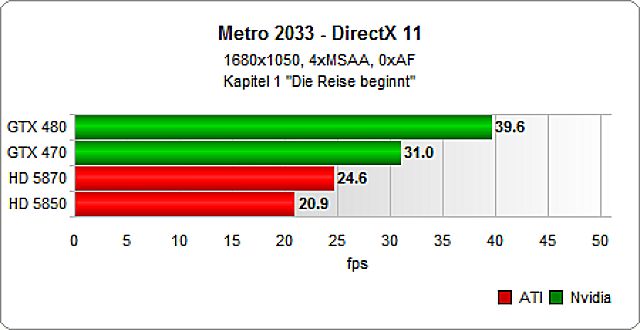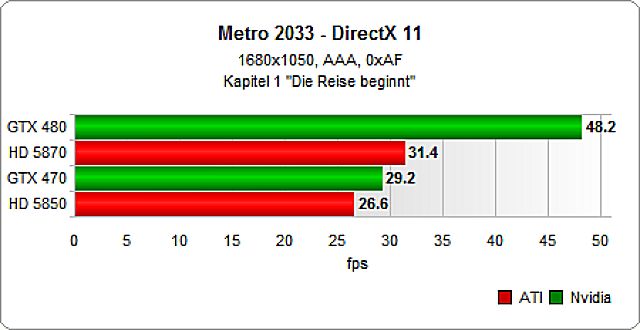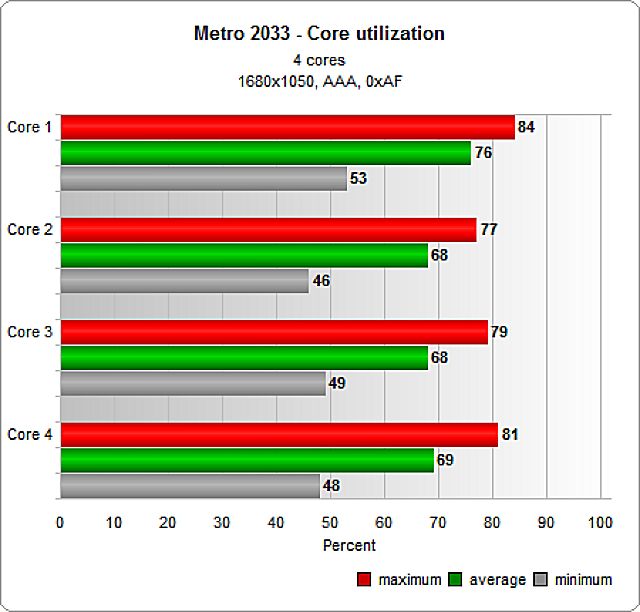The "4A engine" used is such a thing in itself. Unfortunately, there are more rumours than facts circulating and the developers themselves keep themselves relatively covered. However, it seems certain that the basic framework is still based on the old X-Ray engine, as it was also used in S.T.A.L.K.E.R, and that on this basis a new "4A engine" was created by adding the DirectX10 and DirectX11 functionality, as well as PhysX effects. Nothing is known about optimization and efficiency, but we find the results achieved acceptable in relation to the hardware effort, although not outstanding.
We tested a representative scene with the lowest PhysX option, the sound adopts a suitable sound card, so that it can be largely ruled out of influencing the CPU GPU result. In addition, we have completely deactivated AF on the driver side in order to exclude the filter optimizations, which can also distort the result. First of all, only so much: even this circumcision does not contribute to a better end result. There are also some short scenes where the ATI cards don't see a trick at all, as the implemented tessellation is rampant. In the end, we opted for a burden similar to the general course of the game, i.e. with ups and downs in terms of tessellation. And since we are testing high-end cards, we have also kept the options of the graphics menu at the maximum.
Our test system:
| Test | |
|---|---|
| Processor: | Q6600, G0 stepping |
| Clock: | 3.8 GHz |
| Ram: | 8 GB DDR2 1066 CL5 |
| Motherboard: | DFI Lanparty DK X48 T2RS |
| Operating system: | Windows 7 Ultimate X64 |
| Graphics card: | Radeon HD 5870, HD5850, Geforce GTX 480, GTX 470 |
| Driver: | Catalyst 10.3, Forceware 197.17 |
With AAA, it is already at the edge of what is tolerable:
With 4xMSAA, the Radeon cards are already at the end of the
Clean scaling over 4 cores:
Testing higher resolutions seemed a bit pointless in this context, as it was already barely playable. The CPU is quite busy, but not overloaded and did not run slower than a lower clocked i7 system, which we countertested with the same HD5870. This allowed us to ensure that the limitation results exclusively from the graphics card. However, the test shutdown of two cores caused the system to collapse in performance in such a way that a quadcore should be mandatory, at least in the area of high-end cards.
Conclusion:
The game comes with DirectX11 interface. Good and beautiful. But what was ultimately implemented and, above all, how, was a tick too much for us. Because at the latest at this point you really have to ask the question: how much tessellation does such a game really need? Let's stay fair and not let anyone insinuate that a reference game for Nvidia's new GTX480 / 470 should be created here. But: the DirectX11 mode with this immense tessellation forces even an overclocked HD5870 to its knees, and then the red monster in selected places with miserable<10 fps geradezu virtuell zu enthaupten, während der Testablauf mit einer GTX 480 immer noch recht flüssig ablief, sobald 4x MSAA aktiviert war. And even with the AA completely deactivated on the driver side, only the HD5870 can provide reasonably usable frame rates, while the HD 5850 is already running below the limit.
As already mentioned – the reasons are mainly to be found due to the almost excessive use of tessellation, in which pretty much everything is crumbled into additional polygons, which is not at three on the tree. In return, however, you hardly get an optical gain, but only the almost complete exclusion of ATI's 5 series as soon as the tessellation comes into play. Sure, the notoriously limited implementation of this feature in the layout of the ATI cards is an annoying weakness and overwhelms these cards with increased use of tessellation. It is therefore all the more incomprehensible that the deactivation of tessellation or gradation is not offered individually as an option. Here, a little more sensitivity would certainly have helped to avoid one or the other black thought.
The final conclusion, whether inability, thoughtlessness or intent, is better left to the user.
- 1 - Metro 2033: Endzeitstimmung in der Röhre
- 2 - Albtraum über Tage: das Buch, das keiner haben wollte
- 3 - Unter Tage: die Moskauer Metro, der größte Bunker der Welt
- 4 - Reales „Stalin-Addon“: Die geheimen Tunnel der Metro Nr. 2
- 5 - Story: Viel Action, noch mehr Oben-Unten und ein langer Atem
- 6 - Gameplay: Kontrastprogramm aus Chaos und Linearität
- 7 - Benchmark: DirectX11 - der stille Tod des roten Monsters
- 8 - Benchmark: DirectX10 – Schwerathletik statt Morgengymnastik
- 9 - Fazit: Unterirdisches Drama mit himmlischer Umsetzung

































Kommentieren